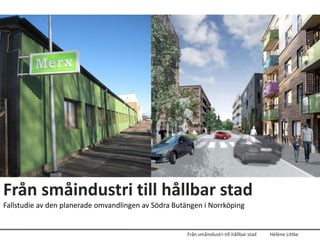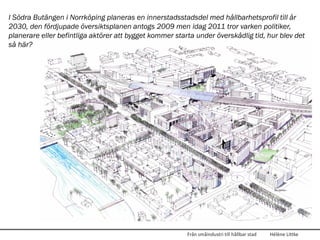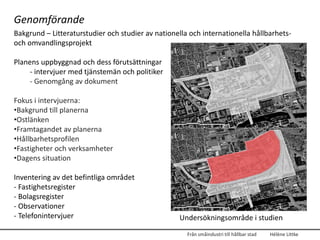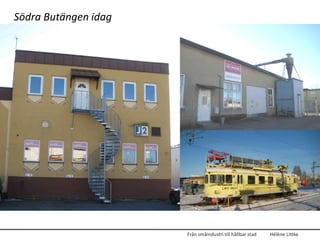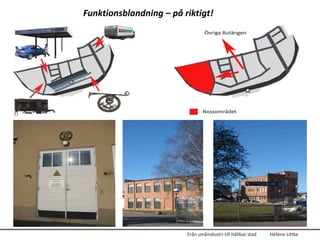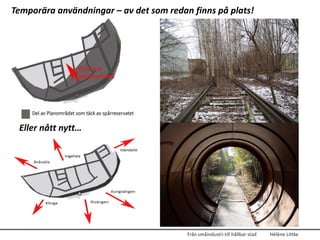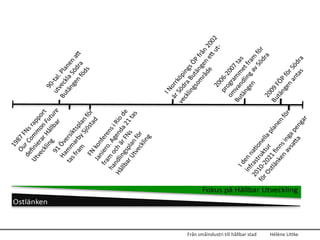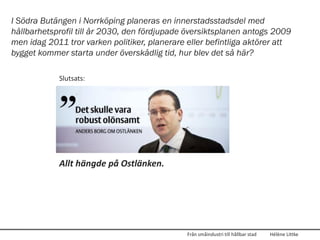Helene Littke
- 1. Från småindustri till hållbar stad Fallstudie av den planerade omvandlingen av Södra Butängen i Norrköping Från småindustri till hållbar stad Hélène Littke
- 2. I Södra Butängen i Norrköping planeras en innerstadsstadsdel med hållbarhetsprofil till år 2030, den fördjupade översiktsplanen antogs 2009 men idag 2011 tror varken politiker, planerare eller befintliga aktörer att bygget kommer starta under överskådlig tid, hur blev det så här? Från småindustri till hållbar stad Hélène Littke
- 3. Genomförande Bakgrund – Litteraturstudier och studier av nationella och internationella hållbarhets- och omvandlingsprojekt Planens uppbyggnad och dess förutsättningar - intervjuer med tjänstemän och politiker - Genomgång av dokument Fokus i intervjuerna: •Bakgrund till planerna •Ostlänken •Framtagandet av planerna •Hållbarhetsprofilen •Fastigheter och verksamheter •Dagens situation Inventering av det befintliga området - Fastighetsregister - Bolagsregister - Observationer - Telefonintervjuer Undersökningsområde i studien Från småindustri till hållbar stad Hélène Littke
- 4. Södra Butängen idag Från småindustri till hållbar stad Hélène Littke
- 5. Södra Butängen idag: Befintliga Verksamheter Från småindustri till hållbar stad Hélène Littke
- 6. Ny verksamhetsindelning: Fastighetsägare •Området består av 49 fastigheter •Kommunen äger idag ca 50% Från småindustri till hållbar stad Hélène Littke
- 7. Funktionsblandning – på riktigt! Från småindustri till hållbar stad Hélène Littke
- 8. Temporära användningar – av det som redan finns på plats! Eller nått nytt… Från småindustri till hållbar stad Hélène Littke
- 9. Från småindustri till hållbar stad Hélène Littke
- 10. I Södra Butängen i Norrköping planeras en innerstadsstadsdel med hållbarhetsprofil till år 2030, den fördjupade översiktsplanen antogs 2009 men idag 2011 tror varken politiker, planerare eller befintliga aktörer att bygget kommer starta under överskådlig tid, hur blev det så här? Slutsats: Allt hängde på Ostlänken. Från småindustri till hållbar stad Hélène Littke
- 11. Avslutningsvis •Stor omvandling, många inblandade och många bakgrunder – hela projektet måste förankras •Stora frågan När, Hur, Var inte Att •Mycket oklar och avlägsen tidshorisont Rekommendationer •Jobba med strategier •Utgå från platsen och de berördas behov •Dra nytta av en omlokalisering – vilken stad vill vi ha? Var finns industrin i framtidens stad? Från småindustri till hållbar stad Hélène Littke

